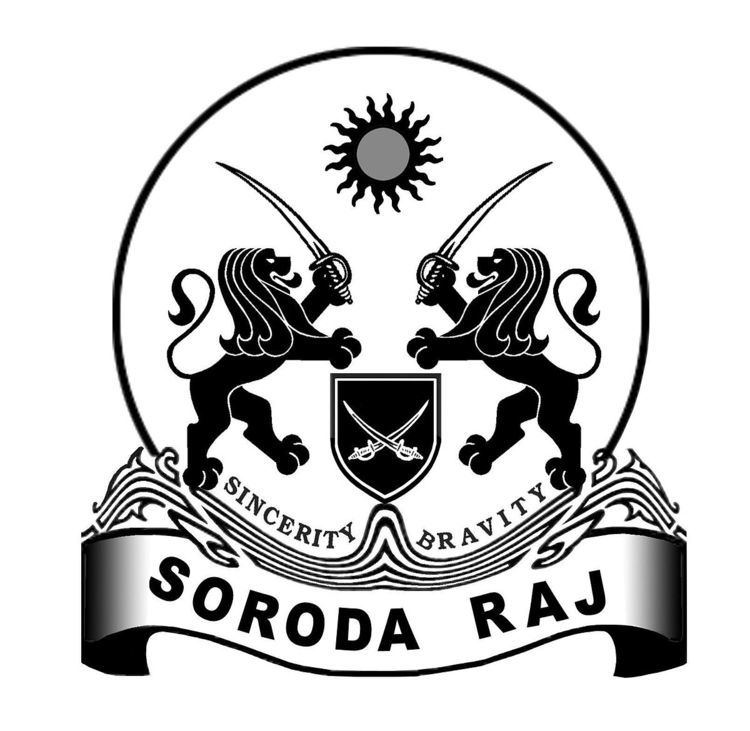 | ||
The Soroda dynasty were the rulers of Soroda, a region in India located in Ganjam District near Berhampur in the present state of Odisha, India. The Soroda dynasty is a part of the Nala dynasty and originated from the Khidisingi clan. They are contemporary to Raja Mukunda Dev-I of Puri and the same is reflected in all the 24 volumes of Raja Mukunda Dev of Puri.
According to the Census Report of T.J. Maltobi of 1880, the Khidisingi Estate was established in 1168 by Raja Sobha Chandra Singh Deo of Sabeijaipur. He was coronated by the Tribel Chief Pattamalik and his four sons on the orders of Goddesses Barahi. The Khidising estate was bounded by Hinjalak(Hinjili) in the east, Kalahandi, Jaipore and Gadapur in the west, Khimandi in the south and Ghumusar in the north. They were devotees of Goddesses Khambeswari or Stambeswari. Goddesses Kandhunidevi is one of the Chata Khamba. Their Gotra is Parasara.
Seven generations of Raja Sobha Chandra Singh Deo ruled the Khidisingi estate peacefully by the successors like Krushna Chandra Singh Deo, Raya Singh Deo, Priti Singh Deo, Padmanava, Bikram Singh Deo and Baliar Singh Deo. In 1476 Raja Baliar Singh Deo divided the Khidisingi into four princely states among his four sons:
The Soroda estate was ruled by Raja Sandhadhanu Singh Deo, his son Raja Shyam Sunder Singh Deo and Raja Kunja Singh Deo peacefully and without much trouble. Raja Kunja Singh Deo accepted the British rule along with other princely states of Ganjam and Orissa. In 1830 Raja Janardhan Singh Deo successed to the throne of Soroda. He was a tyrannical king and also a revolutionary ruler. He refused to pay cess and duties to the Brtishers and as a result of that the soroda estate was auctioned by the Britishers on 09.12.1833 and the king of Ghumusar auctioned it. Raja Janardan Singh Deo organized the tribals of khidisingi and revolted against the Britishers staying at the hilltop of Chakunda forest of Badagada. The Britishers compelled Raja Raghunath Singh of Badagada and arrested Raja Janardan Singh Deo. Raja Janardan Singh Deo and his son Yubraj Sunder Singh Deo again organized the tribels and fought with the king of Ghumusar to take revenge and become successful in their mission. At this instances the Britishers were compelled to grant th inam villages of Sundarraj pur(Lanjipally), Pitala and Dhobadi to Raja Janardan Singh Deo and his son Yubraj Sunder Singh Deo. Raja Sunder Singh Deo was a peace-loving king and preferred to stay in Sundarrajpur (Lanjipally). Raja Sobha Chandra Singh Deo, son of Raja Sunder singh Deo continued to rule Soroda in exile. The system was discontinued for some time and the rituals were continued by the freedom fighter and social activist Late Jagannath Singh Deo at the instances of Great freedom fighter Late Sasi Bhusan Rath and others and is being continued by his son Dr. Debadutta Singh Deo.
The Tree Structure of Saroda Dynasty
- Sobha Chandra Singh Deo
- Krushna Chandra Singh Deo
- Raya Singh Deo
- Priti Singh Deo
- Padmanava Singh Deo
- Bikram Singh Deo
- Baliar Singh Deo: Daman Singh Deo ( Badagada), Sandhadhanu Singh Deo (Soroda), Hadu Singh Deo (Dhorakote), Parsuram Singh Deo (Sheragada)
- Sandhadhanu Singh Deo
- Kunja Singh Deo
- Janardan Singh Deo
- Sundar Singh Deo
- Sobha Chandra Singh Deo
- Chakrapani Singh Deo
- Jagannath Singh Deo : Dr. Debadutta Singh Deo, Bibhudutta Singh Deo, Satyabrata Singh Deo, Subhakanta Singh Deo.
- Dr. Debadutta Singh Deo : Rohit Singh Deo
